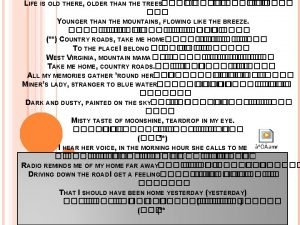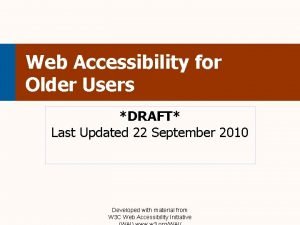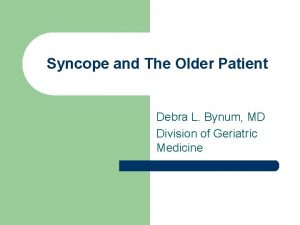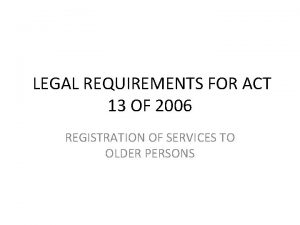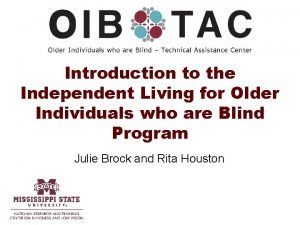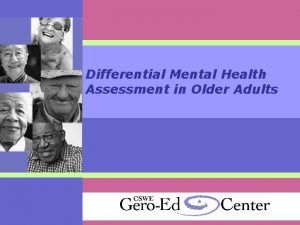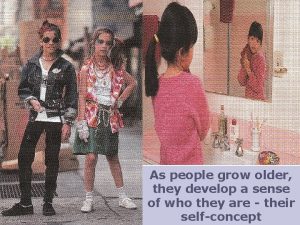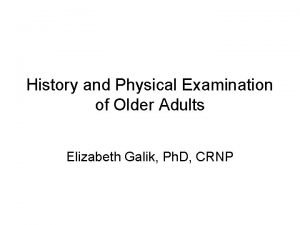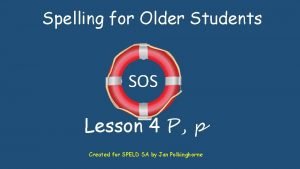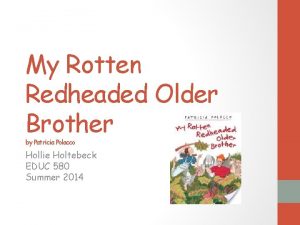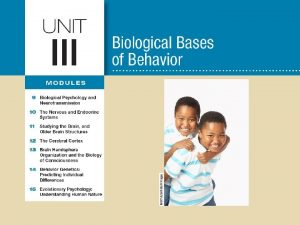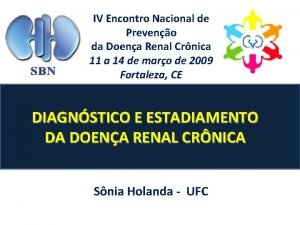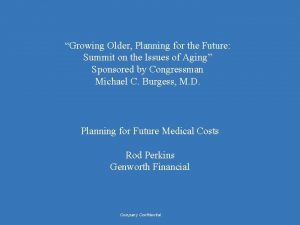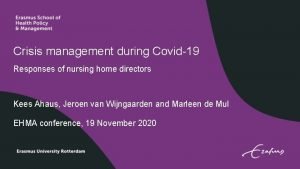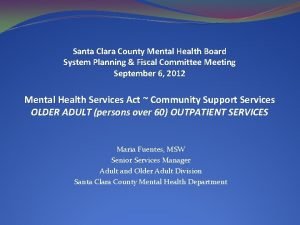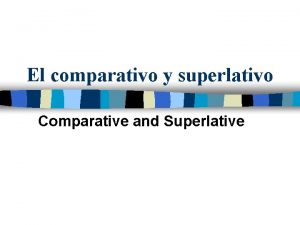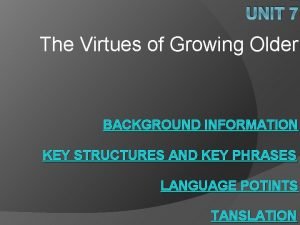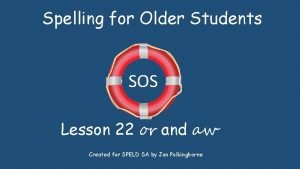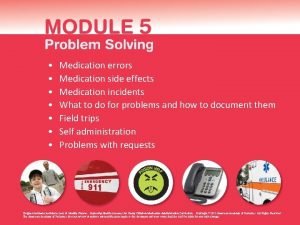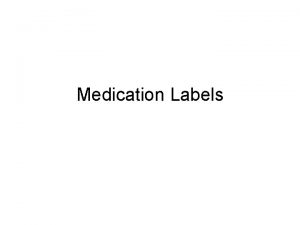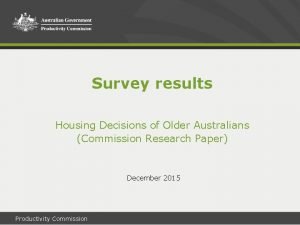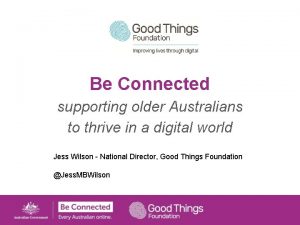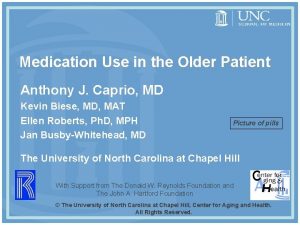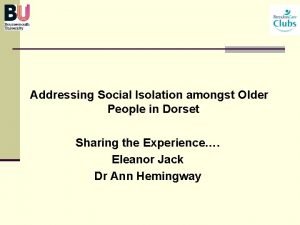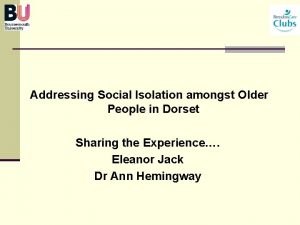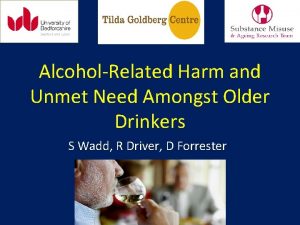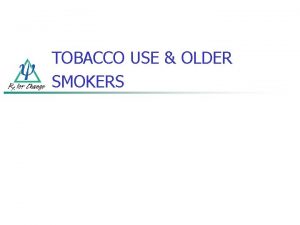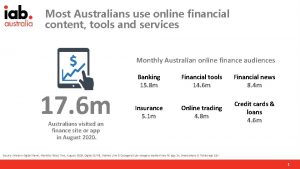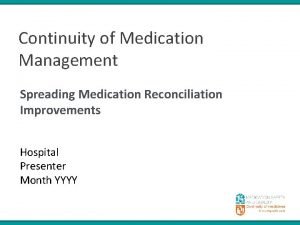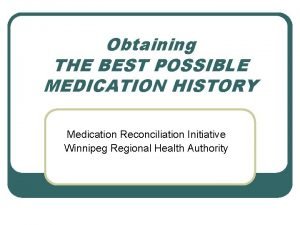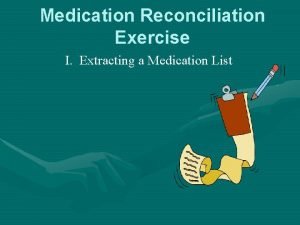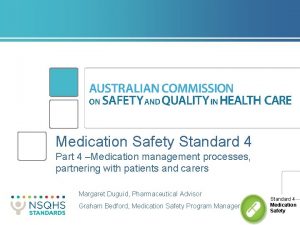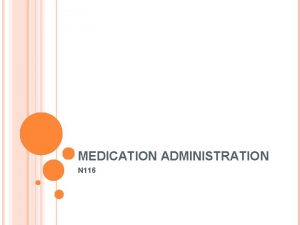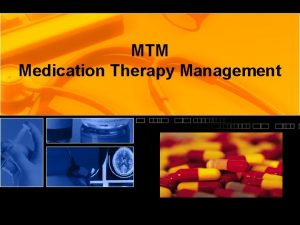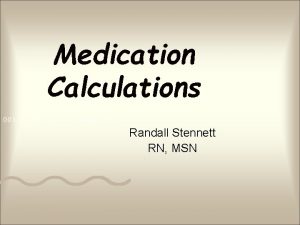Medication use amongst older Australians Analysis of the








![Bio-Psycho-Social Approach • Self-reported health: ‘poor’ – ‘excellent’ • [Medication Use] • Morbidity (baseline) Bio-Psycho-Social Approach • Self-reported health: ‘poor’ – ‘excellent’ • [Medication Use] • Morbidity (baseline)](https://slidetodoc.com/presentation_image_h/8ee3b2745bc15baee4927464631ee8be/image-9.jpg)























- Slides: 32

Medication use amongst older Australians: Analysis of the Australian Longitudinal Study of Ageing (ALSA) data Mary A. Luszcz Matthew Flinders Distinguished Professor School of Psychology Director, Flinders Centre for Ageing Studies

Medication Use • Other speakers have presented some of the general issues concerning use of medicines by older adults • Aim of this Presentation: – Snapshot of medication use among local sample – ALSA – Prescription, OTC, CAM – Some implications, e. g. , for falls

Australian Longitudinal Study of Ageing (ALSA) A population-based panel for exploring the complexity of normative ageing Baseline: 1992, N= 2087; 565 couples equal men & women 88% Australian or UK born Gary Andrews 2 May 1938 – 18 May 2006 2014 - Wave 13 (N = 94) 75% Women Now - ‘oldest-old’, >85 years, M = 89. 7 January 2014: 1, 806 (86%) deaths

Mode of interview and number of participants over time in the ALSA

Methods • Quantitative Approach – Home Interview – Clinical Assessment – Self-complete Questionnaires • Qualitative Approach – Open-ended Question after Clinical Assessment • What are your hopes and fears for your/the future? – Specific Sub-studies: Sleep, Widowhood, Resilience

1994 W 3: Age 80 Interviews & Assessments at Participant’s Home 2010 W 11 Age 95 2013 W 12: Age 99 (Female – 482)

Data Acquisition • W 1, W 6, W 9: Asked to present all drug containers; recorded dose, reason for script, duration taken • W 3: Asked about changes to medication usage and containers • W 7+: Data from HIC/PBS • Mixture of methods mixed blessing

Bio-Psych-Social Approach • Psychological: Affect, Cognition, Morale • Social: Networks, Living Arrangements, Participation, Marital Status, Work History • Functional: Activities, Falls, Mobility • BIO…
![BioPsychoSocial Approach Selfreported health poor excellent Medication Use Morbidity baseline Bio-Psycho-Social Approach • Self-reported health: ‘poor’ – ‘excellent’ • [Medication Use] • Morbidity (baseline)](https://slidetodoc.com/presentation_image_h/8ee3b2745bc15baee4927464631ee8be/image-9.jpg)
Bio-Psycho-Social Approach • Self-reported health: ‘poor’ – ‘excellent’ • [Medication Use] • Morbidity (baseline) arthritis most common, then CVD, hypertension, GI disease, ‘mental health problems’ (mostly with others) • Mortality (1992 +14 years) – increased by 25% if 3 -4 diseases vs 80% >5, cf. none

Caughey et al. (2010)

Median Survival Time & Distribution, Given Baseline Morbidity • no chronic diseases 10. 4 years (12%) • 1 - 10. 2 (23%) • 2 - 9. 6 (24%) • 3 -4 - 8. 9 (28%) • >5 - 6. 4 (13%) (adjusted for age, gender, residential status).

By implication … • the greater the number of co-morbid diseases … the greater the number of medications • so poly-pharmacy as much as polymorbidity at play here… • limitation

Medication Topics Covered • Baseline: Overview of medication use • Over Time: Use of OTC and CAMs • Psychotropic drug use - relationship to falls and fractures

Baseline Overview • 89% taking at least one medication • Average: 3. 2 medications (SD 2. 4) • ~25%: taking at least five medications • One third using non-prescription and prescription combinations • 20% - were non-prescription

Anatomical Chemical Therapeutic Classification (WHO) • To code medications • Groups according to organ or system on which they act • Results for 1993 Version C = Cardiovascular System N = Nervous System A = Alimentary System and Metabolism

10 Most Common Medications Baseline ATC code Generic name % N 02 BA 01 Aspirin 23 N 02 BE 01 Paracetamol 15 C 03 CA 01 Furosemide (diuretic) 14 C 01 AA 05 Digoxin (cardiovascular) 9 C 07 AB 03 Atenolol (beta blocker) 8 C 03 DB 01 Amiloride (diuretic) Isosorbide Dinitrate (vasodilator) 7 C 02 EA 01 Antihypertensives 6 A 02 BA 02 Ranitidine (ulcers) 5 C 01 DA 02 Glyceryl trinitrate (angina) 5 C 01 DA 08 6 Roughhead 1993

With Ageing … • polypharmacy, multiple (co)morbid illnesses and physiological changes: Ø Can increase the risk of adverse drug reactions, hospitalizations, etc • Use of OTC and CAMs is understudied in older adults, especially in Australia & over time

Non-prescription (self-) medications • Over the Counter (OTC) Medicines – E. g. , antacids, antihistamines • Complementary and Alternative Medicines (CAM) – E. g. , herbal and traditional medicines • Estimates of 33% to 50% older people report using 1 or more • ALSA – less usage Goh, Vitry, Semple, Esterman, Luszcz 2009

Self - Medication 1992 -1993 Wave 1 N = 2087 Variable 1994 -1995 2000 -2001 2003 -2004 Wave 3 N =1679 Wave 6 N =791 Wave 7 N =487 N % N % CAM/OTC 404 19. 4% 460 27. 4% 140 17. 7% 173 35. 5% OTC 268 12. 8% 278 16. 6% 79 10% 83 17% CAM 180 8. 6% 241 14. 4% 71 9% 118 24. 2% • No obvious temporal trend or pattern of preferred use • Overall about 10 – 35% use one or both Goh, Vitry, Semple, Esterman, Luszcz 2009

Results: Top classes of CAM and OTC drugs used % CAM % OTC

Who Self-prescribes? • Examined Demographics • Do Age, Gender, Education, Income level or Selfrated Health affect OTC or CAM use? • OTC – no significant effects • CAM – more used by women and at younger ages (65 -79 vs > 80) - used for enhancement of general health, boosting of immune system

Psychotropic Rx and Falls • Consequences or ‘side effects’ • >65 years: 33% incidence of falls 30% accompanied by fractures or other injuries if hospitalised, 50% die within 12 months

Risk factors for falling • environmental (e. g. , poor lighting, loose carpets, slippery flooring, lack of handrails) • intrinsic (e. g. , weak muscle strength or impairment in balance, gait, vision, or cognition) • extrinsic such as use of certain medicines or polypharmacy

Method • 1492 people: waves 1 (1992) and wave 3 (1994) • ‘Persistent Users’: at both waves - 22% (325) vs non-users (1167) [others excluded (187)] • Psychotropic medicines recorded – Antipsychotics – 13% – Anxiolytics - 31% – Hypnotics and sedatives – 12% – Antidepressants – 32% • Confounders: e. g. , gender, arthritis, cognition, depression, balance, gait, strength, other Rx Vitry, Hoile, Gilbert, Esterman, Luszcz 2010

More Persistent Users • female (61. 5% vs. 46. 6%) • older (78. 5 years vs. 77. 1 years) • living in residential aged care (9. 2% vs. 2. 6%) • experiencing dizziness (41. 5% vs. 20. 1%) • poorer mobility (23. 7% vs. 12. 5%) • cognitive impairment (17. 2% vs. 11. 6%) • arthritis (63. 4% vs. 49. 4%) • cataract (53. 4% vs. 23. 2%) • history of stroke or transient ischemic attack (16. 6% vs. 8. 6%)

• Number of Falls reported in 12 months previous to wave 3 – 540 fell (36%) – 2. 5 (6. 3 S. D. ) in non-users vs. 3. 4 (9. 9) in persistent users • Gender modified Risk for Users: Ø F - IRR = 1. 77; (95% CI = 1. 54– 2. 05; p < 0. 0001); Ø M - IRR = 1. 03; (95% CI = 0. 85– 1. 26; p = 0. 72) Ø F - after BMI adjustment, IRR = 1. 22 (95% CI = 1. 02– 1. 45; p < 0. 015) underweight & obese

• Fractures in the previous 2 years persistent users (9. 5% or 30) non-users (3. 9% or 45) • Gender again modified risk for Users: Ø F IRR = 2. 54; (CI = 1. 57– 4. 11; p < 0. 0001) Ø M IRR = 0. 66; (CI = 0. 15– 2. 86; p = 0. 584) Ø F > BMI adjustment: IRR = 1. 92 (p < 0. 015, CI = 1. 13– 3. 24). [underweight]

• Despite some group differences between users and non-users: • Only additional effects attributable to – Gender: female users more falls + fractures – BMI: > Falls if underweight or obese > Fractures if underweight • Persistent use of Psychotropic Drugs is significant risk factor for these older women • > frailty, osteoporosis, dosage/duration?

Outlook • ‘Snapshot’ reveals that only limited attention has been given in ALSA to understanding medication use patterns or their implications • Other domains suggest relatively ‘healthy’ sample, -> underestimate patterns in wider community of older adults

FCAS Staff/Students Dr Tim Windsor Deputy Director, FCAS Dr Linda Isherwood (NILS/FCAS) Dr Mydair Hunter Carla Raphael – Research Assistant Penny Edwards – Program Manager Lesley Sommers – Research/Admin Assistant Dr Chris Materne Dr Kathryn Browne-Yung – (Research Associate) Dr Ruth Walker – (then) ARC Post-doctoral Fellow

Acknowledgement • Prof Andy Gilbert & Colleagues – Dr. Gillian Caughey – Prof Elizabeth Roughead – Dr. Agnes Vitry • Quality Use of Medicines and Pharmacy Research Centre, Sansom Institute, Uni SA • ARC/NHMRC – Ageing Well Ageing Productively Grant (AG –CIA)

Ageing Well Thank You!
 Life is older than the trees
Life is older than the trees Australians all let us rejoice
Australians all let us rejoice Molecular substance
Molecular substance Web accessibility for older users
Web accessibility for older users Tall strong younger sister
Tall strong younger sister Syncope in the older patient is
Syncope in the older patient is Synformal anticline
Synformal anticline Mental health and older adults
Mental health and older adults Dq98 assessment form
Dq98 assessment form Intellectual development in later adulthood
Intellectual development in later adulthood Older individuals who are blind program
Older individuals who are blind program Mental health and older adults
Mental health and older adults Altered cognition in older adults is commonly attributed to
Altered cognition in older adults is commonly attributed to As people grow older
As people grow older Although it was raining maria went for a jog at the park
Although it was raining maria went for a jog at the park The older brother in the prodigal son
The older brother in the prodigal son Bartosz older owl
Bartosz older owl Conclusion of physical examination
Conclusion of physical examination Downsizing and divesting older business
Downsizing and divesting older business Sos spelling for older students
Sos spelling for older students My rotten redheaded older brother
My rotten redheaded older brother Ajayan is ten years older than vijayan
Ajayan is ten years older than vijayan Module 11 studying the brain and older brain structures
Module 11 studying the brain and older brain structures Renal
Renal Future medical
Future medical Which sentence tells you that hoa is older than nien
Which sentence tells you that hoa is older than nien Covids older adults
Covids older adults Moses older sister
Moses older sister Older adults mental health
Older adults mental health Superlativo de trabajador
Superlativo de trabajador The virtues of growing older
The virtues of growing older Sos spelling for older students
Sos spelling for older students Adjectives for younger sister
Adjectives for younger sister
